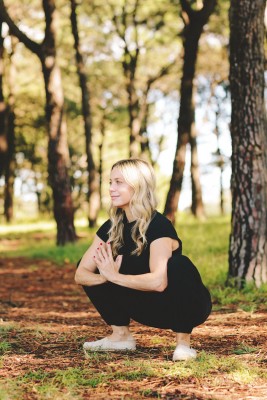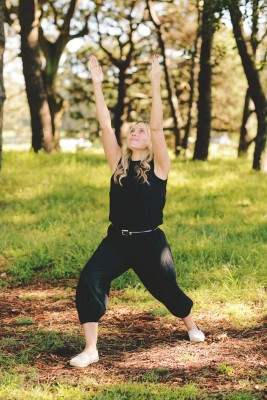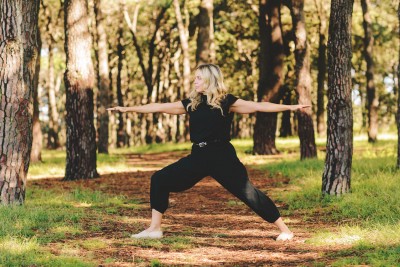Yoga for calmness in times of uncertainty
Learning to relax in the midst of chaos and to stay steady in moments of uncertainty is the path to true awakening.
A psychologist once told me that she believes anyone is capable of dealing with any situation as long as it is known. It’s the uncertainty that unravels most people. According to the yoga teachings, the manifest world is constantly moving through cycles of creation (Brahma), sustenance (Vishnu) and destruction (Shiva). Then the cycle begins again. There are no exceptions to this rule. We never know how long any part of the cycle will last; that’s the great, terrifying unknown. Yet so many of us experience pain clinging to the things we don’t want to end or change and wishing things away we’d prefer would finish or disappear. It’s this inability to accept the basic laws of nature that tell us “the only constant is change, none of us know what comes next.”
The reality is, the only thing we can rely on is change. The world will keep throwing us curveballs. It’s never the things we worry about at three in the morning that come to fruition — it’s the random acts on a Tuesday afternoon that sideswipe us. I mean who imagined in December 2019 the world was about to unravel in the way it has. Life is unpredictable; that’s the deal of being alive. As exciting and terrifying as that is, it’s natural to want to find something solid to cling to. Feeling grounded amid the chaos can bring some ease to the process of change. The practice of yoga provides us with exactly that: a way to sit with uncertainty and ground into the only thing that is not subject to change — that deeper part of ourselves: our consciousness.
What is that deeper part of ourselves?
From the yoga perspective, we are made up of energy and matter. Energy moves through matter all the time. So does consciousness. Where matter is finite, and subject to the laws of manifestation, consciousness is not: it is infinite. It is vast and powerful and not subject to change or the laws of manifestation. Sometimes energy moves through a tree, so consciousness can experience itself as a tree, or an ant or a “Rachael”. So there is this part of “Rachael”, absolutely experiencing itself as finite — my body, my mind, my “Rachael”-ness, my experience of the external world. And at the same time, there is this part of “Rachael” that is pure consciousness, awareness, not subject to change. That is the truly powerful part of the self, that yoga practice gives us access to.
How can we stay steady when nothing else is?
Connect to the infinite
It’s important to use your yoga practice to feel the infinite part of yourself because it’s only available at the feeling level. Using asana (yoga postures), meditation and pranayama, we are peeling back the layers to use the body and mind and breath to feel what is beyond that.
Feeling grounded amongst the chaos can bring some ease to the process of change.
In a pranayama practice, for example, we get curious about the breath. We play with controlling and freeing it so we can feel who and what we are beyond the breath. The breath shows us that we are subject to the laws of manifestation. I have a beginning (I inhale), a middle (the pause at the top of the breath) and an end (I exhale and empty the breath). Then the cycle begins again. The breath is always changing. A challenging asana pose shows us this at the physical level. Our time on the mat reveals to us at a cellular level, but can you also feel this part of you that is infinite? Even for a second? It may not be the yoga mat that reveals it to you; it may be walking bare foot in nature, surfing, listening to music — anything that brings you a moment that connects you to your true “home”, that deeper part of the self.
Starting with the roots
According to the yoga physiology, the energetic body is very complex with different systems and layers. One aspect of this is the chakra system. It’s said there are seven energy centres that are placed along the spine where the central energetic channel (shusumna) is. The base chakra (muladhara) is associated with the earth element, and so it determines how grounded we feel, how well we connect to the earth. Mula, in this context, means root. Adhara can be support or foundation. Dhara can mean flux. How balanced we are in the muladhara chakra will be represented by how deep our roots are and how connected to the earth we feel; therefore, how steady our support or foundation is whether grounded or in a constant state of flux.
It all begins at the roots
Root systems are incredible. They grow deeply into the earth to constantly provide the rest of the plant with life-bringing minerals. The trunk, stems, leaves, their life depends on the health of the roots. This is why it’s so important to nourish our roots. In those unsteady moments, in those times of flux, no matter what the conditions our roots run deep and we will be OK. We can withstand the weather. The seasons will change, from blustery winter to the new beginnings of spring. We have the capacity to withstand it all.
However, when the roots aren’t nourished, when our foundation isn’t stable, we live in a constant state of fight or flight.
How to nourish your roots
Tribe
There are many ways to balance muladhara and nourish your roots. Having a deep connection to tribe is a very powerful way to start. Community gives us a sense of belonging; being connected to this planet in some way. Fostering a healthy, supportive relationship with family, friends, your work tribe and community can make you feel like you are home. You are safe. These people have capacity to hold you through every storm. It’s why satsang, or keeping good company, is considered one of the most important yogic practices in today’s world by my teachers Sharon Gannon and David Life. I know life is busy, but it is essential we prioritise our connection to tribe if we desire an easeful journey through the inevitable uncertainty of life. When we have conflict with our people or we aren’t putting time and energy into fostering those connections, our foundations will feel shaky. It’s a very good reason not only to spend more time with those you love, but to resolve relationships that keep you stuck feeling unsafe and unsteady in this world. Resolution doesn’t always look like kissing and making up.
Fostering a healthy, supportive relationship with family, friends, your work tribe and community can make you feel like you are home.
Sometimes it’s a process of forgiveness and letting go so we can use that energy being wasted on resentment and sadness to grow our own precious roots. Sometimes it means setting boundaries to create a healthier dynamic.
Food
Another way to nourish your roots is through the physical body. Think about how well plants do when they are hydrated and getting plenty of sunlight. The same goes for us. Drink lots of water and herbal teas like turmeric. Eat foods that are red or earthy colours like root vegetables such as potato, sweet potato, pumpkin, red onion and carrots. Warm, roasted vegetables and dals help ground on a physical and cellular level.
Asana
Learning to stand steadily on your own two feet is the starting point to balance muladhara. It’s why Shri Pattabhi Jois made everyone master the standing series first in the Ashtanga system, before they were given any of the other poses. When we need grounding, the standing poses are magic. And all the other poses lie in them. Master them and you master your life.
Yoga sequence for uncertainty
In this grounding series, take a good five to eight breaths in each pose. Notice what happens when you stay steady in a pose: feel the earth beneath your feet and find balance.
Squat or garland pose (Malasana)
Set feet hip width or wider. Bend the knees, toes in line with knees. Spread weight evenly over feet. Hands in prayer, forearms parallel to earth. Press elbows into knees while keeping palms together. Climb the spine taller and ground down into the earth by pressing feet down and crown of head up.

Goddess (Uttkata konasana)
Step the feet wide, and bend knees. Set knees over heels, and don’t let them go beyond the toes. Externally wrap thigh bones around to set knees in line with middle toe. Don’t arch the lower back, lengthen the tail. Have hands on hips, or prayer at heart centre, or arms out to side, bending elbows in line with shoulders, like cactus arms.

Chair pose (Uttkatasana)
Big toes touch and separate heels so that second toe lines up with centre of heel or feet hip width. Bend knees, hands to hips or reach arms up, hands shoulder width or palms connecting. Keep weight spread across four corners of feet. Shift the shins back trying to set knees over ankles. Pick the frontal hip bones up and descend sit bones to the earth.
Warrior 1 (Virabhadrasana 1)
Set your feet up so they are a little short of one leg length apart, hips pointing forward. Either have heel to heel alignment, or feet hip width apart. Front foot is in tadasana pointing forward, back foot turning in about 45 degrees. Connect the whole sole of the back foot to the earth. If you can’t do so, step it forward a little or out to the side to hip distance apart. Bend the front knee. Knee above heel. Equal weight through both feet. Hands to hips, or reach the arms up, palms facing one another together or shoulder width apart. Soften shoulders down.

Warrior 2 (Virabhadrasana 2)
Step the feet wide, about one leg length apart. Heels in line. Toes turned in a little. Lift the quad muscles and pelvic bones up. Climb the ribs up. Look at the right leg and turn right toes out, setting right foot parallel with the long side of the mat, wrap the right thigh bone out and around to set the knee at a 90-degree angle, over the ankle, in line with the second toe. Left hip forward. Pick the front of the pelvis up and reach the arms out so they’re parallel with the earth. Soften shoulders down.

Triangle (Trikonasana)
Keep the feet about one leg length apart, legs extended. Heels in line. Back toes turned in a little. Lift the quad muscles and pelvic bones up. As you take your hand down to a block, shift your hips back. Make sure the front thigh bone is wrapping out and around in external rotation to set the knee in line with the toes. Firm the back leg. Find equal weight in both feet.

Images: Tessa Tran








